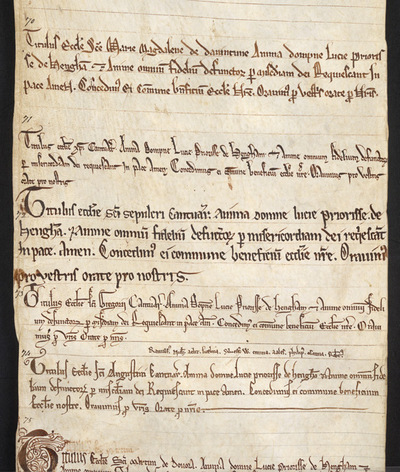Javascript must be enabled to continue!
The Obituary Roll Of Lucy, First Prioress Of Hedingham tituli 70 to 74
View through Europeana Collections
Lucy de Vere was the founder and first prioress
of the Benedictine nunnery of Hedingam in Essex. When she died,
probably around 1225 her successor, Agnes, sent this roll -- now
over 19 feet long and composed of several strips of parchment sewn
end-to-end -- out to other religious houses, announcing Lucy's
death and asking them to pray for her soul. As it passed around
East Anglia and back and forth across southern England, each of
them added an inscription asking for reciprocal prayers
(tituli).This section (tituli 70-74) displays a relative uniformity
of handwriting styles. Most of the tituli on it were written by
communities in Canterbury and, because of the high level of skills
of their scribes and their need for impressive documents, the
majority of the tituli are written in formal styles, such as
charter styles or the formal style used for liturgical books. The
religious houses include the cathedral (Corpus Xi or Corpus
Christi), Holy Sepulchre, St Gregory and St
Augustine.
Title: The Obituary Roll Of Lucy, First Prioress Of Hedingham
tituli 70 to 74
Description:
Lucy de Vere was the founder and first prioress
of the Benedictine nunnery of Hedingam in Essex.
When she died,
probably around 1225 her successor, Agnes, sent this roll -- now
over 19 feet long and composed of several strips of parchment sewn
end-to-end -- out to other religious houses, announcing Lucy's
death and asking them to pray for her soul.
As it passed around
East Anglia and back and forth across southern England, each of
them added an inscription asking for reciprocal prayers
(tituli).
This section (tituli 70-74) displays a relative uniformity
of handwriting styles.
Most of the tituli on it were written by
communities in Canterbury and, because of the high level of skills
of their scribes and their need for impressive documents, the
majority of the tituli are written in formal styles, such as
charter styles or the formal style used for liturgical books.
The
religious houses include the cathedral (Corpus Xi or Corpus
Christi), Holy Sepulchre, St Gregory and St
Augustine.
Related Results
The Obituary Roll Of Lucy, First Prioress Of Hedingham
tituli 24 to 29
The Obituary Roll Of Lucy, First Prioress Of Hedingham
tituli 24 to 29
Lucy de Vere was the founder and first prioress
of the Benedictine nunnery of Hedingam in Essex. When she died,
probably around 1225 her successor, Agnes, sent this roll -- now
ove...
The Obituary Roll Of Lucy, First Prioress Of Hedingham
tituli 30 to 38
The Obituary Roll Of Lucy, First Prioress Of Hedingham
tituli 30 to 38
Lucy de Vere was the founder and first prioress
of the Benedictine nunnery of Hedingam in Essex. When she died,
probably around 1225 her successor, Agnes, sent this roll -- now
ove...
The Obituary Roll Of Lucy, First Prioress Of Hedingham
tituli 115-121
The Obituary Roll Of Lucy, First Prioress Of Hedingham
tituli 115-121
Lucy de Vere was the founder and first prioress
of the Benedictine nunnery of Hedingam in Essex. When she died,
probably around 1225 her successor, Agnes, sent this roll -- now
ove...
Hugh Mendes | Francis Bacon & Emile Bernard Obituary Paintings
Hugh Mendes | Francis Bacon & Emile Bernard Obituary Paintings
We are pleased to exclusively present two new Hugh Mendes paintings which represent a new evolution in his work. Mendes is well known for his obituary paintings that have in recent...




